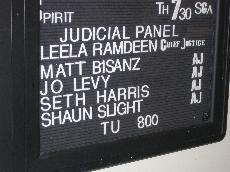By Brendan O’Reilly
On Tuesday, the University Student Government Association voted on whether to remove an impeached associate justice of the SGA judicial panel, after holding off on the matter since Oct. 31.
The motion to remove Matthew Bisanz was made by Patrick McDonald. Bisanz was found by the senate to have breached SGA rules by allegedly violating the confidentiality of executive session. He was accused of revealing the budgets of campus clubs to The Chronicle.
For the consideration of the motion to remove Bisanz, the senate was brought into executive session, meaning the gallery was forced to leave the meeting. Those who were present are barred from repeating what was said during the closed session.
After debate on the removal ended and the vote was held, the senate left executive session, allowing the gallery to reenter the room. It was revealed that the motion to remove Bisanz failed. The motion required a two-thirds vote of the senate. With approximately a dozen senators absent at the time of the vote, almost all present senators would have had to vote yes.
However, Seth Harris, an associate justice on the judicial panel who was permitted into the session along with the other justices, said the senate voted overwhelming against removing Bisanz.
McDonald spoke against the motion to enter executive session. “Keeping our deliberations translucent is tantamount towards the student body knowing what we do.”
“Once again, this is an example of following Robert’s Rules when it’s convenient. What do we have to hide from the students, except the fact that people who were not present at the trial will be voting for his removal?” said McDonald, before moving to vote on entering executive session.
After Russell Akiyama, the SGA vice president, announced the senate would be entering executive session and asked the gallery to leave, McDonald attempted to circumvent the exclusiveness of the closed session.
“I move that anyone in the gallery and anyone who wishes to enter the gallery be allowed to enter executive session,” McDonald said. His motion was met with laughter however, as allowing reporters and others to enter the gallery during the session defeats its purpose.
Lisa Giunta, the Rules Committee chairwoman, said that Robert’s Rules of Order force the SGA to enter executive session when discussing alleged wrongdoing, to protect the body from litigation. “It is otherwise considered libel to judge someone in an official matter, as it is not a legal case,” Giunta said.
Persons cannot be sued for accusations and defamatory statements made in an actual courtroom, but the SGA is not afforded that protection if they make attacks against someone’s character on public record.
Bisanz said he planned on having a processor serve the SGA with a lawsuit on Tuesday, but said his plans changed after a University administrator said a suit against the SGA would be a suit against the school.
“As it’s my understanding that if a student sues the University, the University reserves the right to expel them for suing, although I haven’t seen that in writing.” Had he been removed, Bisanz said he would have appealed to the University to overturn the senate’s decision, and if that failed he would have filed suit after he graduated in May.
In preparing his case, Bisanz had found more than a dozen charges, including defamation, deceit, coercion, deprivation of rights, actions contrary to justice and intentional infliction of emotional distress. Bisanz said he was preparing to sue specific individuals as well as the senate as a whole.
“Until I’m served with documents, it’s not real to me,” said Pete DiSilvio, the SGA president, of the possibility of being sued by Bisanz.
Bisanz said because he is not being removed from the judicial panel, he will not be bringing suit and feels the matter has been resolved.
Disclosure: Bisanz is a columnist for The Chronicle

A motion to remove student government judicial panel Associate Justice Matthew Bisanz failed in the Senate on Tuesday.
